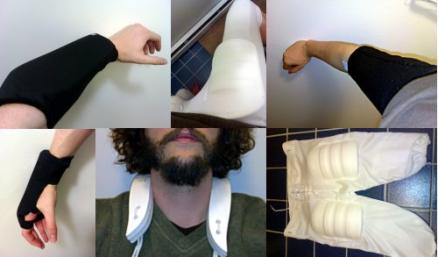ScanBand v0.4 is go!
At last, version 0.4 of my ScanBand prototype has rolled off the presses (or, at least, the printer in the lab.) This version tossed out the color strip, which turns out to be less useful than I had hoped. It is also significantly narrower, making it more like existing mid-upper arm circumference measuring devices. There is also a window alongside the scanning window that displays the millimeter measurement in numbers, so that the band is still useful in situations with computers or power.
Even more importantly, the version is able to be print two ScanBands completely on a single 8.5x14 inch sheet of paper, BUT can also (potentially) print out on a continuous roll from a 3-4 inch wide label printer. I'd really like to test this latter scenario in Malawi, since the good folks at Baobab have indicated that this might be a great way to print these out as needed.
Attached to this post is the zip file with the PDF of the most recent version.
- Mike's blog
- Comments



- 3109 reads
The Rules for "Guns"
When I was a kid growing up on army bases, the most popular game played by kids my age was called "Guns." We would come up to each others' houses, find our friends, and ask them, "Wanna play guns?" And they always would.
Here at the rules for "Guns", as they emerged over a couple of years in my section of barracks:
Players are divided into two teams. The teams are usually, though not always, designated as "US" and "Soviets."
Each player selects a toy gun from the collective neighborhood cache of plastic weapons. It is typically good form to select guns appropriate to one's side (e.g. plastic AK-47 goes to the Soviet side.) Also, the better looking weapons should tend to go to older players.
- Mike's blog
- Comments
- Read more



- 3821 reads
ScanBand v0.2

Version 0.2 of scanband increases the size of the measuring window to 5 mm and adds a colored warning strip to allow for quick diagnosis of dangerously diminished mid-upper arm circumference. The barcode gradient in this might be inverted (snafu) and the strip still needs a numerical readout. Also, a window system that folds over the strip, rather than relying on cut slits, would be easier to fit on patients.
- Comments



- 9800 reads
First Outside Critic Presentation
ScanBand v0.2Thursday night marked the first presentation of my thesis work to outside critics. It went well, despite a snafu with the barcode scanner that prevented the ScanBand from displaying its results on screen. As a non-digital user scenario, though, it was fine.
Here's the breakdown of my presentation. I've also attached the PDF of the show and a PDF of the version 0.2 ScanBand prototype, which is made available under the Creative Commons Attribution-ShareAlike License 3.0
- Mike's blog
- Comments
- Read more



- 3504 reads
Solar Jacket in The New Yorker
For me, the annual New Yorker Style Issue is usually thin on content and long on made-up 15 year olds looking studiously blase about their Burberry togs. But this issue featured an article by Henry Alford called "Solar Chic," where the author user tests a Zegna bomber jacket with removable solar panels in the collar. The solar panel fed a battery in the breast pocket which, in turn, would charge standard 5-volt devices like music players and phones. The piece could almost be a case from the Knight et al. paper.
- Mike's blog
- Comments
- Read more



- 4072 reads
Comfort, Wearables, and a Peripersonal Space Experiment
I've been doing a lot of work on anthropometrics, and I found the articles for this week to be really helpful for my thesis research. I have been thinking about how to measure vital signs on a patient's body in a way that is inexpensive, accurate, and user-friendly, both for the patient and the technician. Equally important, however, is that a measuring device should be wearable, by the authors' definitions, if only for a short time.
In "The Comfort Assessment of Wearable Computers," by James Knight, et al., the authors invented a multidimensional test for describing the feelings of comfort or discomfort for a wearable device. I'm a freak for numbers and hard data, so it's nice to have this tool available to me for evaluating prototypes. I am especially glad to see how the evaluations are broken down, getting rid of the unhelpful, single variable comfortable/uncomfortable and allow researchers to get more toward the point of what actually is making the user uncomfortable with a device.
More specific to the design of the devices themselves, in "Design for Wearability" Gemperle et al. delineated the constraints for device placement, form, allowance of movement, peripersonal space, attachment, and several other considerations. For me, this could work as a checklist as I create new devices and wearables, making sure I've considered all of the problem areas. I especially appreciated their breakdown of good places to site the devices, which helps give me a starting point for how to shape and attach them.
Rounding out the readings, Dunne and Smyth's "Psychophysical Elements of Wearability" dove more into the neurological side of comfort, which I also liked. I have done a bit of work with haptic interfaces before, and the deadening of response to a continuous stimulus is something I've noticed. If you want the user to notice an output, the stimulus must be fresh. On the flip side, if you want the user to not attend to the device, it must be comfortable (that is, it must not irritate the nerves.)
I think the Dunne and Smyth article sums up something for me that I have been thinking about for a while. For a wearable to be successful, in my opinion, it must be peripheral. In their terms, it must be something that is subconsciously processed but not attended to. Important input from the wearable may be perceived by the user and later attended to, but it should otherwise fall into the background noise of the rest of the world.
With all this in mind, I conducted a little experiment with some equipment I picked up at Modell's, a local sporting goods chain store. I picked up a set of Adams Forearm Pads, Adams Football Pants, Adams Football Thigh Pads, Adams Neck Roll (flat contour), a pair of Trace Hand-Guard Plus, Nike Dri-FIT Sliding Pad, and a Nathan L.E.D. Wrist Runner. I put on the pants with the thigh pads inserted, put the forepad on my left forearm, the sliding pad on my upper right arm with the thickest part on my tricep, put the neck roll loosely over my shoulders, and put the hand guard on my left hand. Then I performed ordinary tasks to see how I reacted to these additions to my body in daily life.
 Collage of Sports Protection Equipment: First row: Adams Forearm Pad, Adams Football Thigh Pad, Nike Dri-FIT Sliding Pad Second row: Trace Hand-Guard Plus, Adams Neck Roll (flat contour), Adams Football Pants
Collage of Sports Protection Equipment: First row: Adams Forearm Pad, Adams Football Thigh Pad, Nike Dri-FIT Sliding Pad Second row: Trace Hand-Guard Plus, Adams Neck Roll (flat contour), Adams Football Pants
- Mike's blog
- Comments
- Read more



- 11996 reads
Blogging "Blog This"
On Saturday, Cameron Browning and I joined up with the boys from Mein Stiffi and had a projection party with Splnlss on his roof in Williamsburg, Brooklyn. We were testing out a project I've dubbed "Steadman," which is a crazy looking drawing tool we created on a slow day in the lab this past August. The results remind me a lot of Ralph Steadman's work.
We've been sort of picking at it now and then. It has tablet support, so you can take your handy Wacom and use the pressure of the pen to adjust the madness of the line you're drawing. Next up... maybe some way of animating the output when it's done. Suggestions are welcome.
- Mike's blog
- Comments
- Read more



- 4745 reads
First Two Weeks
So far so good. I met with Marko this morning and worked through what needs to be done next. I have to start researching a lot about the patent and copyright situation with what I want to do, because I really want to make sure that this work is free (as in freedom) and that it stays free (i.e. no one scoops it up, locks it down, and sells it back to the people at high cost). I don't expect that to happen, but it's better to be safe than sorry, and I really want this to be shared as widely as possible.
Doing more work for Yury, too--top secret stuff for now. Should be really cool when it comes out, though. I was working in Processing today for some demo work, and I solved a lot of issues I'd had before with exporting apps and making them presentable. Sweet!
- Mike's blog
- Comments
- Read more



- 3898 reads
Random Object Composition 3

More of a pattern than a composition at this point. Andi suggested using masks to go through it and pick out interesting compositions that are hidden inside of it, then blowing up the masked area to full size. I'll do this with a few differently sized masks and see what I come up with.
- Comments



- 11446 reads
Random Object Composition 2

The stronger composition. One comment suggested that it looked Soviet, which I agree with. I might make some small changes at the bottom of this one, but not too much else.
- Comments



- 10249 reads
tags
Copyright Mike Edwards 2006-2009. All content available under the Creative Commons Attribution ShareAlike license, unless otherwise noted.

